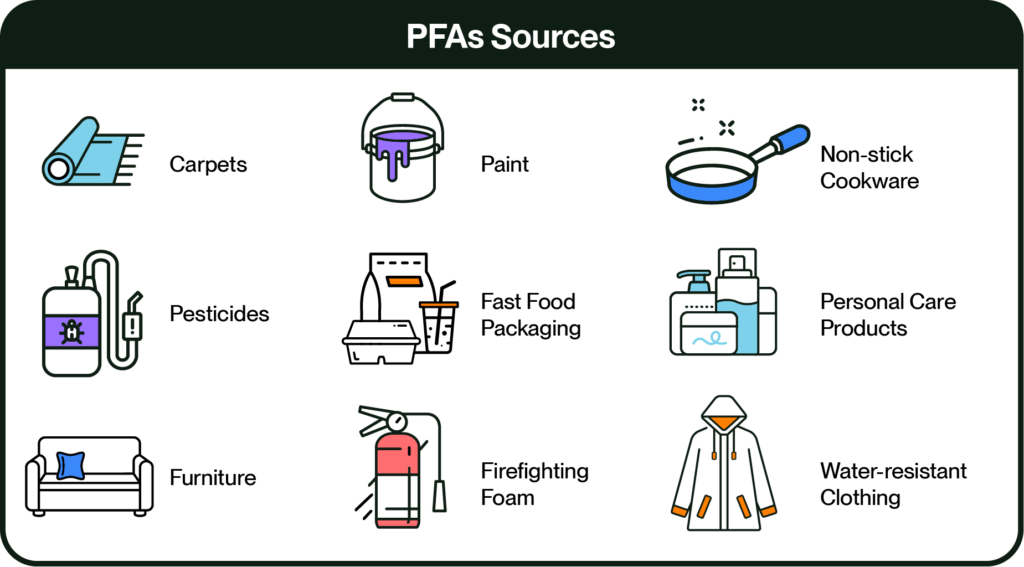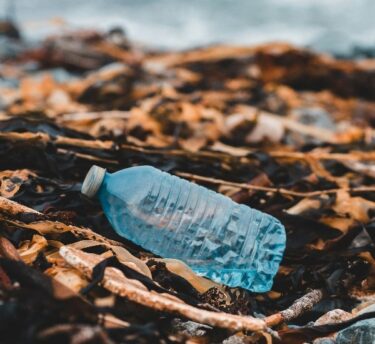Home – Regulations – PFAS Regulations
Table of Contents
- EU PFAS proposals
- US PFAS landscape
- Risks & impacts
- Anthesis PFAS Services
- Frequently Asked Questions
Share this guide
PFAS, or per- and polyfluoroalkyl substances, are a group of more than 12,000 synthetic chemicals that have been used in a wide range of products and industries. These substances are known for their ability to resist heat, water, and stains, which has made them popular in products such as non-stick cookware, food packaging, and firefighting foam. They are also used in other everyday products, like waterproof clothing, furniture and carpets, and personal care items.
Despite their useful properties, environmental concerns and health risks associated with PFAS have spurred nations into action, resulting in a flurry of regulatory developments.

The European Union’s PFAS Restriction Proposal
On February 7, 2023, Denmark, Germany, Norway, Sweden, and the Netherlands jointly submitted the EU PFAS Restriction Proposal, aiming for a blanket ban on all PFAS chemicals. The proposal, defined by the European Chemicals Agency (ECHA), emphasises the persistent nature of PFAS and urges a reduction in environmental emissions. Notably, the proposal lacks specific sector or product categorisations, differentiating it from U.S. regulations.
The EU’s current PFAS legislation, already established for years, includes restrictions on PFOS and PFOA. Additionally, PFHxS has been added to the Stockholm Convention, marking a proactive step. The REACH regulation designates specific PFAS chemicals as Substances of Very High Concern (SVHC). The proposal for PFAS use in firefighting foams underscores the EU’s commitment to a precautionary approach.
The UK’s Unique Approach to PFAS
Post-Brexit, the UK’s Health and Safety Executive (HSE) considers a nuanced approach, focusing on health and environmental impacts. Unlike the EU’s broad proposal, the UK contemplates a ban on a select group of PFAS, aligning restrictions with substances that pose health and environmental risks. Drinking water standards, disposal guidelines, and product-specific manufacturing restrictions are anticipated components.
The United States’ Varied Regulatory Landscape
In the U.S., PFAS regulation is evolving at federal and state levels. High-profile lawsuits have heightened awareness, prompting states like Minnesota to pass comprehensive laws restricting unnecessary PFAS uses. The EPA has proposed regulations, including enforceable limits in drinking water, aligning with ongoing state-level efforts.
PFAS Risks, Exposure, and Impacts
PFAS, known for their resistance to heat, water, and stains, have found their way into various products, including non-stick cookware, food packaging, and firefighting foam. Alarming studies reveal PFAS in the blood of 97% of Americans, emphasising the ubiquitous exposure. The health impacts range from immune disorders to potential links with cancer, making regulatory actions imperative.
Future Directions and Industry Implications
While Europe and the U.S. are at different stages in PFAS regulation, both regions signal a shift away from PFAS. The proposed EU regulations face criticism for potential enforcement challenges, while U.S. regulations are influenced by state-led initiatives. Industries are grappling with the need for alternatives and assessing the feasibility of compliance.
Navigating the PFAS Landscape
At Anthesis, we help companies understand the implications of PFAS regulation on their business, identify hotspots in their supply-chain where PFAS contamination is likely, and provide expertise on alternatives. Our chemistry experts can help decrease the risk of regrettable substitutions by performing in-depth alternative studies and providing guidance on steps to transition to more sustainable products. We are committed to helping our clients remove high risk and hazardous materials from their portfolio through analysis, evaluation, and innovation.
Anthesis provides several services that assist companies in addressing PFAS in their products, including:
- Assessing the implications of PFAS regulation on the business
- Help companies identify, track, and manage PFAS across supply chains
- Perform in-depth alternative materials analysis to decrease the risk of regrettable substitutions
- Develop roadmaps and best practice guidance for transitioning to sustainable products
As global scrutiny on PFAS intensifies, navigating this complex regulatory landscape demands strategic foresight, industry collaboration, and a commitment to sustainable practices.
Frequently Asked Questions
PFAS have been known to stay in the human body for years and do not break down in the environment. According to a study by the CDC, PFAS have been found in the blood of 97% of Americans. People are exposed to PFAS through various avenues, such as contaminated water or food, using products with PFAS, or breathing air contaminated with PFAS. PFAS can also be leaked into the soil, water, and air over time, especially when used in services such as aerospace, automotive, construction, and electronic industries. Improper disposal of PFAS can result in the contamination of soil and water.
PFAS have been linked to several potential health impacts in humans, including cancer, immune system disorders, and developmental effects. Some studies have also suggested that exposure to PFAS may increase the risk of certain types of cancer, such as liver, testicular, and pancreatic cancer. Additionally, individuals who are located close to PFAS-contaminated waters have shown increased rates of adverse medical effects.
In addition to their potential impacts on human health, PFAS can also have negative effects on the environment. For example, these substances can accumulate in the bodies of animals, leading to potential impacts on their health and reproductive capabilities. PFAS can also interfere with the normal functioning of ecosystems, as they can disrupt the balance of species and cause negative impacts on biodiversity.
In response to the potential health and environmental impacts of PFAS, national and international regulators have begun to take action to reduce the use of these substances. For example, the European Union has banned the use of certain PFAS in food contact materials, and the United States has identified several PFAS as hazardous substances that are subject to reporting and management requirements under the Superfund law.
In addition to regulatory efforts, many companies have also taken steps to reduce the use of PFAS in their products. Some companies have developed alternatives to PFAS or have implemented programs to phase out the use of these substances. In the food packaging industry, alternatives to PFAS-based materials include paper, cardboard, and plant-based materials. In the firefighting industry, alternatives to PFAS-based foams include water, foam concentrates made from plant-based materials, and other synthetic foams. Retailers such as REI have made commitments to ban PFAS from all their textile and cookware products from suppliers, with the restriction aimed to take effect in fall of 2024.
However, transitioning to PFAS alternatives can present some challenges and considerations. It may be necessary to consider the performance and cost of the alternative materials, as well as any potential impacts on human health and the environment. It may also be necessary to invest in research and development to identify and develop new alternatives to PFAS.
PFAS contamination poses a great risk to human and environmental health. There are a range of solutions to addressing the harmful implications of using PFAS, such as stopping the flow of new PFAS into the market and pushing for stronger federal and state regulations against PFAS.
Get in touch
Related Content
Get in touch
We’d love to hear from you
We are the world’s leading purpose driven, digitally enabled, science-based activator. And always welcome inquiries and partnerships to drive positive change together.








